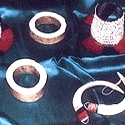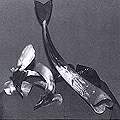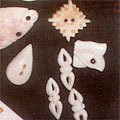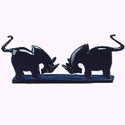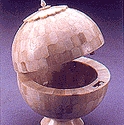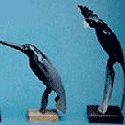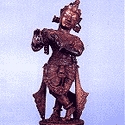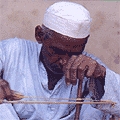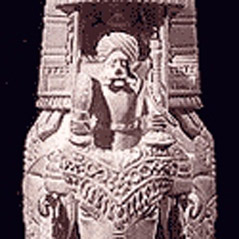Horn and Bone Crafts,
Horn craft, especially the carving of buffalo horns - to make bird and animal figures, utility items like combs, cigarette cases, and tobacco pipes, as well as items like necklaces, bracelets, pendants, rings, hair-pins, tie-pins, key tags, cuff links, belt buckles and fan handles - has a long tradition; however, the legal ban on ivory has made horn and bone carving much more common. Buffalo horns are not very difficult to obtain and very reasonably priced. Horn craft is generally found at Bodimaluwa and Joolgahakanda in Galle district on the southern coast of the country.
Horn craft, especially the carving of buffalo horns - to make bird and animal figures, utility items like combs, cigarette cases, and tobacco pipes, as well as items like necklaces, bracelets, pendants, rings, hair-pins, tie-pins, key tags, cuff links, belt buckles and fan handles - has a long tradition; however, the legal ban on ivory has made horn and bone carving much more common. Buffalo horns are not very difficult to obtain and very reasonably priced. Horn craft is generally found at Bodimaluwa and Joolgahakanda in Galle district on the southern coast of the country.
HISTORY & TRADITION
In ancient times the handles of weapons were carved with horn and the pill boxes of the Vedarala were made of turned horn. Horn combs, elaborately carved, were made by superior craftsmen, while the other common horn combs were made by rodiyo (smiths) or by members of the beraavyo or duraya castes.
PROCESSES & TECHNIQUES
1. THE PROCESS
The first step in the craft process is to boil the horn in water. A certain chemical ingredient is added, the nature of which is kept secret from non-practitioners. This softens the material, making it more pliable and easier to handle. After this, the horns are cut, sawn, or drilled according to the requirements of the products to be made. The item is then polished and often decorated with silver inlay. This is done manually.
2. TOOLS & PROCESSES
A horn comb maker has with him a small adze (1 ½ inch cutting edge), a coarse rasp, a few knives, an awl for marking, a vice, two or three saws, a file, and a few tools that are used to incise the patterns. These iron tools are made by local artisans. The combs are made of buffalo horn cut transversely; the tops of the horns are used for tool and knife handles. A flat piece of horn is sawn off and cut roughly in the shape of a comb. This is made thinner with an adze and rasp and then finished with a knife.
The lines for the inner ends of the teeth and for required patterns are marked with an awl; this is a small bone tool with a sharp point, which is inserted near one end. The comb is now set in the vice and this is held conveniently against the stone with the pressure of the artisan's legs. The vice has two pieces of wood that are tied together near one end, and a wedge is inserted at the other end. When the wedge is driven in, the short ends of the vice grip tightly whatever is placed between them. The vice is ornamented with some primitive carving. The teeth of the comb are then made - on one side the teeth are very small and cut with a fine saw; on the other side coarse teeth are cut with a thicker saw. The teeth are cut with surprising quickness. Each tooth is then filed at the back and the front to make the edges smooth. The comb is finally polished with a mixture of wood ashes and horn shavings. Patterns are made on the comb with either a chisel-shaped instrument or a two or three point iron tool before polishing.
Horn and Bone Crafts of Nepal,
A recent development in the field of hand-crafted products in Nepal is the use of the buffalo and cattle horns to make a range of buttons, hair ornaments, jewellery, and decorative figures.
A recent development in the field of hand-crafted products in Nepal is the use of the buffalo and cattle horns to make a range of buttons, hair ornaments, jewellery, and decorative figures.
PROCESS & TECHNIQUE
Horn is a versatile raw material and the artisans have shown a keen sensitivity to the material by using its diverse grains and colour variations to great advantage. When heated and oiled, horn becomes soft and pliable and the artisan can then mould and shape the horn into the required shape. The grain of the material and the variations in colours are used to create - naturally - subtle effects while crafting the product.
PRODUCTS
The range of utilitarian products crafted from horn includes buttons, trays, cigarette cases, little boxes, ash-trays, pen stands, and lamps. Ornamental hair pins, combs, and faux copies of jewels used as hair decorations are also made. Some are intricately carved with trellis patterns.
PRACTITIONER'S LOCATION
Horn is a raw material that is available almost everywhere. However, the crafting of the products, is mainly carried out in the three towns of the Kathmandu Valley.
Horn Carving of Andhra Pradesh,
Horn is a versatile raw material and artisans have shown keen sensitivity by using its grain and variations in colours to great advantage. When heated and oiled horn becomes soft and pliable. Bison horns are in great demand owing to the size. Vishakapatnam is a well-known centre for horn craft and the artisans are especially well-known for crafting horn walking sticks.
Horn is a versatile raw material and artisans have shown keen sensitivity by using its grain and variations in colours to great advantage. When heated and oiled horn becomes soft and pliable. Bison horns are in great demand owing to the size. Vishakapatnam is a well-known centre for horn craft and the artisans are especially well-known for crafting horn walking sticks.
Horn Carving of Karnataka,
This is practised mainly in Belgaum in Karnataka. The grain of the material and the variations in colours are used subtly while crafting the products. When heated and oiled, the horn becomes soft and pliable. The most common product is the comb --- traditional, double-sided with gentle carvings, or more decorative with ivory or mother-of-pearl inlay. The other items are ornamental hair pins, combs, and faux copies of jewels used as hair decorations. Some are intricately carved with trellis patterns while others have a hollow which has oil which flows out as the comb is passed through the hair. Buttons, trays, cigarette cases, little boxes, ash trays, pen stands, and lamps are also made.
This is practised mainly in Belgaum in Karnataka. The grain of the material and the variations in colours are used subtly while crafting the products. When heated and oiled, the horn becomes soft and pliable. The most common product is the comb --- traditional, double-sided with gentle carvings, or more decorative with ivory or mother-of-pearl inlay. The other items are ornamental hair pins, combs, and faux copies of jewels used as hair decorations. Some are intricately carved with trellis patterns while others have a hollow which has oil which flows out as the comb is passed through the hair. Buttons, trays, cigarette cases, little boxes, ash trays, pen stands, and lamps are also made.
Horn, Bone, Ivory and Mother of Pearl of Rajasthan,
After the ban on ivory the artisans moved on to carving artefacts in horn and bone. The articles made include handles for weapons, like swords and daggers, howdahs for riding on elephants, palanquins, thrones, couches, and divans. The other items made are salvers, tumblers, jewellery, hukka bases, and toys carved in the shape of animals, birds, and fish. There are figurines depicting gods and animals, mythological motifs, and folk motifs depicting the intricacy of carving. The other items made are bangle boxes, chessmen, animal figures, combs, and paper cutters, some of which are painted. In the boxes, the jali is intricately cut and perforated, with floral patterns as well as human and animal figures. There is a unique item known as bartana, shaped like a paper knife, which is passed between the forehead and the turban to ease tension. The main centres for this craft are Jaipur, Ajmer, Bikaner, and Jodhpur. Jodhpur is famous for its bangles of various sizes which cover the whole arm, from the wrist to the shoulder. These bangles are often decorated with glass beads, coloured lace, gold leaf, or a simple colour ornamentation. Pieces of seashell are stuck together around bone to from a mosaic-like outer layer. This is mainly used as a decorative item. This craft is mainly practised in Jodhpur.
After the ban on ivory the artisans moved on to carving artefacts in horn and bone. The articles made include handles for weapons, like swords and daggers, howdahs for riding on elephants, palanquins, thrones, couches, and divans. The other items made are salvers, tumblers, jewellery, hukka bases, and toys carved in the shape of animals, birds, and fish. There are figurines depicting gods and animals, mythological motifs, and folk motifs depicting the intricacy of carving. The other items made are bangle boxes, chessmen, animal figures, combs, and paper cutters, some of which are painted. In the boxes, the jali is intricately cut and perforated, with floral patterns as well as human and animal figures. There is a unique item known as bartana, shaped like a paper knife, which is passed between the forehead and the turban to ease tension. The main centres for this craft are Jaipur, Ajmer, Bikaner, and Jodhpur. Jodhpur is famous for its bangles of various sizes which cover the whole arm, from the wrist to the shoulder. These bangles are often decorated with glass beads, coloured lace, gold leaf, or a simple colour ornamentation. Pieces of seashell are stuck together around bone to from a mosaic-like outer layer. This is mainly used as a decorative item. This craft is mainly practised in Jodhpur.
Horn, Bone, Ivory Carving of Delhi,
Delhi has long been renowned for ivory carving. A variety of ivory ware, both decorative and utilitarian, was produced. This included exquisitely carved elephant tusks, perforated table lamps, traditional chess-sets, boxes, small painted panels, and contemporary jewelry. With the ban on the use of ivory, craftspersons have turned to other substitutes such as bone, wood and horn for carving.
Delhi has long been renowned for ivory carving. A variety of ivory ware, both decorative and utilitarian, was produced. This included exquisitely carved elephant tusks, perforated table lamps, traditional chess-sets, boxes, small painted panels, and contemporary jewelry. With the ban on the use of ivory, craftspersons have turned to other substitutes such as bone, wood and horn for carving.
Horn, Bone, Ivory Carving of Kerala,
Horn as a raw material is available almost everywhere across the sub-continent. Craftspersons use the grain of the material and the variations in colour to great advantage. Buffalo, bullock and bull horn carving is carried out in Trivandrum, Trichur, Kasaragod, Ernakulam, and Cochin. Palakkad district. Buffalo horn is commonly used due to its large size and tapered base; bullock horns are smaller and used for crafting smaller objects; while bull horns are only seldom used since it is hollow and suitable only for carving specific parts that require their use for instance the tail of the peacock. The process begins with the upper layers of the horn being stripped off with chisels; the desired shape is marked with chalk, and the extraneous surfaces are sawn or chiseled off. The horn may also be moulded to the desire shape by softening it through heating; it is then tempered with water and polished. The horn is sandpapered and rubbed with the spine of a soaked leaf from the kadaplaava or small jackfruit tree this process induces a milky liquid to form and settle on the surface of the horn. A black, sooty paste-prepared by burning a palm leaves or panayola and mixing the residual ash with water - is rubbed onto the horn until its surface heats up doe to friction and the paste is absorbed into the grainy structure of the horn and lends it a fine sheen. Textures are created by applying a mixture of chalk and adhesive to etched patterns; the polished areas gleam while the etched areas catch colour. Common products include models of birds and animals, toy furniture, and miniature snake boats. Utilitarian items like paper weights, vases, buttons, trays, little boxes, pen stands, lamps, cigarette cases, and ashtrays are also made. Kerala cranes are particularly famous as are animals like elephants and tigers. Till the ban on ivory Kerala was reputed for its ivory carving and Trivandrum was the most important centre. Earlier the products made were images of deities and sacred animals. The ivory carvers have now shifted to horn, bone and wood and they continue to carving mythological figures and natural objects. The more common representations are of Shiva as Nataraja, Shiva-Parvati, Ganesh, Subrahmanya, Vishnu Sarasvathi, and Lakshmi. Carving is done with a chisel very gently to avoid damage. Apart from carving, designs are also etched on to the surface. Floral or geometrical patterns, birds, animals, and jungle scenes are carved in bass relief. Another specialty of Kerala is a set of over 100 miniature elephants sealed in a small shell with a diameter of 0.5 cm. Kerala also had a rich tradition of ivory painting. The area to be painted was smoothened with sandpaper and the outline of the picture was sketched on it in pencil. It was pierced with a needle and water colours applied on the surface with a pointed brush so that the colour penetrated the little holes. The tools used include the electric motor and needles.
Horn as a raw material is available almost everywhere across the sub-continent. Craftspersons use the grain of the material and the variations in colour to great advantage. Buffalo, bullock and bull horn carving is carried out in Trivandrum, Trichur, Kasaragod, Ernakulam, and Cochin. Palakkad district. Buffalo horn is commonly used due to its large size and tapered base; bullock horns are smaller and used for crafting smaller objects; while bull horns are only seldom used since it is hollow and suitable only for carving specific parts that require their use for instance the tail of the peacock. The process begins with the upper layers of the horn being stripped off with chisels; the desired shape is marked with chalk, and the extraneous surfaces are sawn or chiseled off. The horn may also be moulded to the desire shape by softening it through heating; it is then tempered with water and polished. The horn is sandpapered and rubbed with the spine of a soaked leaf from the kadaplaava or small jackfruit tree this process induces a milky liquid to form and settle on the surface of the horn. A black, sooty paste-prepared by burning a palm leaves or panayola and mixing the residual ash with water - is rubbed onto the horn until its surface heats up doe to friction and the paste is absorbed into the grainy structure of the horn and lends it a fine sheen. Textures are created by applying a mixture of chalk and adhesive to etched patterns; the polished areas gleam while the etched areas catch colour. Common products include models of birds and animals, toy furniture, and miniature snake boats. Utilitarian items like paper weights, vases, buttons, trays, little boxes, pen stands, lamps, cigarette cases, and ashtrays are also made. Kerala cranes are particularly famous as are animals like elephants and tigers. Till the ban on ivory Kerala was reputed for its ivory carving and Trivandrum was the most important centre. Earlier the products made were images of deities and sacred animals. The ivory carvers have now shifted to horn, bone and wood and they continue to carving mythological figures and natural objects. The more common representations are of Shiva as Nataraja, Shiva-Parvati, Ganesh, Subrahmanya, Vishnu Sarasvathi, and Lakshmi. Carving is done with a chisel very gently to avoid damage. Apart from carving, designs are also etched on to the surface. Floral or geometrical patterns, birds, animals, and jungle scenes are carved in bass relief. Another specialty of Kerala is a set of over 100 miniature elephants sealed in a small shell with a diameter of 0.5 cm. Kerala also had a rich tradition of ivory painting. The area to be painted was smoothened with sandpaper and the outline of the picture was sketched on it in pencil. It was pierced with a needle and water colours applied on the surface with a pointed brush so that the colour penetrated the little holes. The tools used include the electric motor and needles.
Horn, Bone, Ivory of Odisha,
Due to the ban on ivory craftspeople have shifted their skills in ivory carving to horn craft. Palakhemundi and Cuttack are known for the horn work, from which stylised animal forms and utility items are made. The horn used is from cow and buffalo which is skillfully converted into ashtrays, jewellery, and figures of birds and animals. Utility products like bangles, decorative combs, hair jewels and perfume jars (ittardanis) are also made and ornamented with silver filigree work to create an unusual look. Carvings of Mithuna figures in bone are made in Odisha. The Tribal Santhals, Orans, Marijas make carved combs out of bone and horn.
Due to the ban on ivory craftspeople have shifted their skills in ivory carving to horn craft. Palakhemundi and Cuttack are known for the horn work, from which stylised animal forms and utility items are made. The horn used is from cow and buffalo which is skillfully converted into ashtrays, jewellery, and figures of birds and animals. Utility products like bangles, decorative combs, hair jewels and perfume jars (ittardanis) are also made and ornamented with silver filigree work to create an unusual look. Carvings of Mithuna figures in bone are made in Odisha. The Tribal Santhals, Orans, Marijas make carved combs out of bone and horn.
Horn, Bone, Ivory of Uttar Pradesh,
Lucknow has been a prominent center for ivory carving. From creating court objects for the Nawabs of Awadh to carrying out the craft on furniture as initiated by the British, ivory carving has been a significant part of the craft repertoire. Due to the worldwide ban on ivory, the the craftsmen has since been carving on camel and buffalo bone and horns. Products like openwork boxes, lamps, scissors, paper knives, pen stands, buttons, earrings, necklaces, rings, pendants and ambari elephant are crafted by the artisans. Sarai Taran is a well-known centre for horn work cutlery handles, and engraved furniture. Tools such as saw/ari, file/chaursi ret, half round file, che inchi tipehal to sharpen files, drill/barma, divider/prakaar, sandpaper are used during the carving process.
Lucknow has been a prominent center for ivory carving. From creating court objects for the Nawabs of Awadh to carrying out the craft on furniture as initiated by the British, ivory carving has been a significant part of the craft repertoire. Due to the worldwide ban on ivory, the the craftsmen has since been carving on camel and buffalo bone and horns. Products like openwork boxes, lamps, scissors, paper knives, pen stands, buttons, earrings, necklaces, rings, pendants and ambari elephant are crafted by the artisans. Sarai Taran is a well-known centre for horn work cutlery handles, and engraved furniture. Tools such as saw/ari, file/chaursi ret, half round file, che inchi tipehal to sharpen files, drill/barma, divider/prakaar, sandpaper are used during the carving process.
Horn, Bone, Ivory of West Bengal,
The main centres of ivory-carving in West Bengal are Khagra and Jiagunj in the Murshidabad district. The ivory-carvers belong to the pashana (stone) group of the traditional sutradhar caste. The ivory-carving is secular in character as it is a mixture of Hindu folk forms and Islamic designs. The items carved range from a king sitting under a howdah to an Ambari or royal elephant which has beautifully carved legs, exquisitely worked ivory panels and figurines that are part of simhasanas, thrones, beds and palanquins, scenes form a royal procession of elephants, elephants and horses dressed for different occasions, and ornamented boats of different sizes like the mayur pankhi boat with prows shaped like peacock heads with a party of tiny dancers on board. The other examples are chariots with horses, bullock carts, elephants crossing a bridge, decorative patterns carved out of an entire tusk, decorative panels and carved legs for furniture, magnificently carved and engraved jewellery and jewellery boxes, chessmen, and lamps of varying kinds. There are also carvings of Buddha and copies from Chinese ivory-carvings. The Murshidabad ivory-carvers carve figures of Hindu gods and goddesses --- Durga, Lakshmi, and Ganesh. The style of carving is different for these religious figurines. The ban on ivory has resulted in a dwindling of the number of practising artisans and a shift to rose wood and sandal wood carving with encouraging results. Horn comb craft was very popular in West Bengal until the first quarter of this century. Though cheaper replacements have arrived it is still used by the rural population as they believe horn combs are good for the hair and scalp. This craft is practised in the villages of Baishnab Chak, Jyot Ghanashyam, Narayan Chak, Dongabhanga, and Tamluk in the Midnapur district of West Bengal. The Midnapur craftspersons make combs of many designs and shapes. The artisans belong to the pashana or stone group of the sutradhar caste.
The main centres of ivory-carving in West Bengal are Khagra and Jiagunj in the Murshidabad district. The ivory-carvers belong to the pashana (stone) group of the traditional sutradhar caste. The ivory-carving is secular in character as it is a mixture of Hindu folk forms and Islamic designs. The items carved range from a king sitting under a howdah to an Ambari or royal elephant which has beautifully carved legs, exquisitely worked ivory panels and figurines that are part of simhasanas, thrones, beds and palanquins, scenes form a royal procession of elephants, elephants and horses dressed for different occasions, and ornamented boats of different sizes like the mayur pankhi boat with prows shaped like peacock heads with a party of tiny dancers on board. The other examples are chariots with horses, bullock carts, elephants crossing a bridge, decorative patterns carved out of an entire tusk, decorative panels and carved legs for furniture, magnificently carved and engraved jewellery and jewellery boxes, chessmen, and lamps of varying kinds. There are also carvings of Buddha and copies from Chinese ivory-carvings. The Murshidabad ivory-carvers carve figures of Hindu gods and goddesses --- Durga, Lakshmi, and Ganesh. The style of carving is different for these religious figurines. The ban on ivory has resulted in a dwindling of the number of practising artisans and a shift to rose wood and sandal wood carving with encouraging results. Horn comb craft was very popular in West Bengal until the first quarter of this century. Though cheaper replacements have arrived it is still used by the rural population as they believe horn combs are good for the hair and scalp. This craft is practised in the villages of Baishnab Chak, Jyot Ghanashyam, Narayan Chak, Dongabhanga, and Tamluk in the Midnapur district of West Bengal. The Midnapur craftspersons make combs of many designs and shapes. The artisans belong to the pashana or stone group of the sutradhar caste.
Household Items,
Hand-made household items like coconut graters, granite stone spice crushers with a stone rolling pin, wooden mortar and pestle and coconut shell spoons can be sourced.
Hand-made household items like coconut graters, granite stone spice crushers with a stone rolling pin, wooden mortar and pestle and coconut shell spoons can be sourced.
